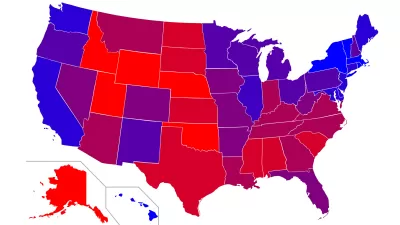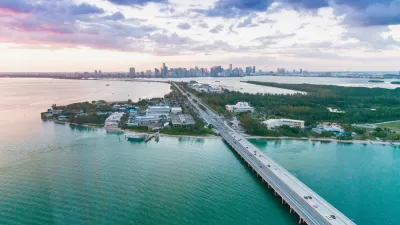In this op-ed, Arthur B. Laffer and Stephen Moore analyze the recent Census findings showing renewed migration from the Northeast and Midwest to the South and Southwest. They note the movement is clearly from blue states to red, and explain why.

The earlier Census Bureau findings reported here showed the movement to predominantly politically red (Republican) states from blue (Democratic) states. Laffer, a member of President Reagan’s Economic Policy Advisory Board for both of his two terms (1981-1989) and chairman of Laffer Associates, and Moore of the Wall Street Journal's editorial board, attribute the economic attraction of the red states to three reasons:
- Low or zero income taxes: "We predict that within a decade five or six states in Dixie could entirely eliminate their income taxes. This would mean that the region stretching from Florida through Texas and Louisiana could become a vast state income-tax free zone", they write.
- Business-friendly, as in the restrictiveness of regulations that could stifle business growth. The fracking moratorium in New York is held up as a model for "business-unfriendly" and point to neighboring Pennsylvania where the natural gas industry is flourishing. In energy-intensive Texas, four of the top ten metro areas (in growth) were located.
- Having "right-to-work" laws that make it more difficult to unionize workers. In addition, they blame high minimum wage laws that "price low-income workers out of the job market."
Laffer and Moore see domestic migration as vindication that the low tax and business friendly policies of red states are succeeding while high tax and business unfriendly policies in the blue states are failing.
Readers responded - offering additional reasons for the domestic migration.
See the 15 fastest growing large metros in this Washington Post article.
Correspondent's note: Access to Wall Street Journal articles for non-subscribers may be limited after April 11.
FULL STORY: Opinion: Laffer and Moore: The Red-State Path to Prosperity

Study: Maui’s Plan to Convert Vacation Rentals to Long-Term Housing Could Cause Nearly $1 Billion Economic Loss
The plan would reduce visitor accommodation by 25,% resulting in 1,900 jobs lost.

North Texas Transit Leaders Tout Benefits of TOD for Growing Region
At a summit focused on transit-oriented development, policymakers discussed how North Texas’ expanded light rail system can serve as a tool for economic growth.

Why Should We Subsidize Public Transportation?
Many public transit agencies face financial stress due to rising costs, declining fare revenue, and declining subsidies. Transit advocates must provide a strong business case for increasing public transit funding.

Dear Tesla Driver: “It’s not You, It’s Him.”
Amidst a booming bumper sticker industry, one writer offers solace to those asking, “Does this car make me look fascist?”

A Visual Celebration of Manhattan’s Chinatown Elder Community, Through Food
Lanterns, cafeteria trays, and community connection take center stage in this stunning photo essay.

How to Make US Trains Faster
Changes to boarding platforms and a switch to electric trains could improve U.S. passenger rail service without the added cost of high-speed rail.
Urban Design for Planners 1: Software Tools
This six-course series explores essential urban design concepts using open source software and equips planners with the tools they need to participate fully in the urban design process.
Planning for Universal Design
Learn the tools for implementing Universal Design in planning regulations.
City of Santa Clarita
Ascent Environmental
Institute for Housing and Urban Development Studies (IHS)
City of Grandview
Harvard GSD Executive Education
Toledo-Lucas County Plan Commissions
Salt Lake City
NYU Wagner Graduate School of Public Service




























